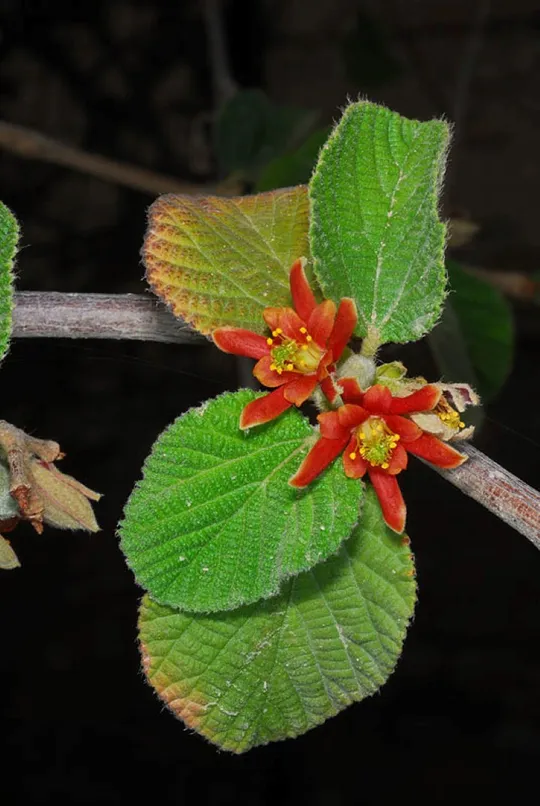Mallow Raisin, Mallow-leaved Ross Berry
Grewia villosa



Grewia villosa
grows in a
single site, in the Dead Sea region, at the Metsoke Dragot Junction. Until the 1970s two
sites were known –KibbutzMitspe Shalem
and Metsoke Dragot Junction, only 2km apart. The establishment of the kibbutz
destroyed the main plant population. It
had consisted of dozens of plants and now only one site remains, with four shrubs. Some years the shrubs look dry – completely "dead". In 2003, leaves sprouted
in all four shrubs and they bloomed in February. In
2005, they sprouted leaves but did not blossom.
According to the literature there were formerly two
more populations of Grewia in the Dead Sea area, south of En Gedi and in the southern Dead Sea, but these data have not
been confirmed since the 1950s.
At the feet of precipices and rocky slopes
particularly in hot desert habitats. Also in rocky wadis near these slopes. Grewia villosa is a typical
shrub of the dry savannas in the
Sudanian region.
The genus Grewia has 150 species, found in
the tropical regions of the Old World. Most of the species
are shrubs found in savannas, and a minority grows on the margins of tropical
forests.
The Kibbutz Mitspe Shalem population of Grewia villosa
grows at the foot of the water reservoir.
When the kibbutz was established the
late Meir Shawat, then director of the Mount Scopus Botanical Garden transferred a number of plants to Kibbutz En Gedi (Shawat, 1979).
G. villosa produces fruits and seeds that germinate easily. Seedlings were planted in the gardens of Kibbutz Mitspe Shalem and in the Botanical Garden of Kibbutz En Gedi. The species has
become a noxious weed and germinates naturally in shaded irrigated gardens. Additional
shrubs from the Mitspe Shalem population were planted in the En Gedi Nature Reserve, at the
field studies center and at the entrance of the David Stream Reserve
·
Formerly there were two adjacent sites of G.
villosa, but
only a single site survived near Mitspe Shalem, with only four shrubs.
·
G. villosa
does not grow on
the cliffs and in the oases of the Dead Sea on the Jordanian side, or in eastern Sinai. The geographical disjunction is considerable: the Mitspe Shalem site is 1,500 km away from Red Sea coast of southern Egypt,
from where G. villosa shrubs were reported.
·
The population is not protected in a nature reserve. Although it is close to the road, access to it is difficult due to the steep rocky slope.
Nevertheless, work on the road or nearby can inadvertently cause the destruction of the population.
Signs should be put up at the site of the existing
Grewia villosa population to explain the importance of the
place. The original population should be reintroduced (easy to propagate, see above) to a site near Kibbutz Mitspe Shalem, in a suitable habitat. These populations should be monitored
and their demographics
should be tracked.
Grewia villosa is common
over extensive areas in the Paleotropical region, particularly in tropical arid areas in Africa and Asia: in almost all the African countries, from South Africa to Mauritania and Cape Verde, and especially in the Sahel from
Ethiopia, Sudan, Chad, up to Algeria. In Asia, it grew in the Deccan region in
southern Iran,
southern Afghanistan, Rajasthan in India and southern Pakistan. In the Middle East it grows in Upper Egypt, the western Arabian ridge (Madina
- Yemen – Hadhramaut), Dufar, Oman, and southern Iran. G. villosa does not grow in Jordan or in eastern
Sinai.
Grewia villosa is a typical Sudanian shrub, which grows in dry savannas, and in Israel grows
between rocks in the extreme desert. G. villosa is found in the wild at only a single site, in which only four shrubs survived. This is the only site in the entire Levant, and it is 1500 kilometers away from other
natural sites. All these make it one of the rarest plants in the country and a highly
prioritized red plant, even though it
is not an endemic species.
שמידע, א. ואור, י. 1983. הצמחייה הסודנית בישראל. רתם 8. החברה להגנת הטבע.
Current Occupancy Map
| 1000 squre meter pixel | 5000 squre meter pixel | 10000 squre meter pixel | |
|---|---|---|---|
| number of observations | 0 | 0 | 0 |
| in total pixels | 0 | 0 | 0 |
| Family | Tiliaceae |
| Classification | On the endangered species list |
| Ecosystem | Desert |
| Chorotype | Sudano-Decanian |
| Conservation Site | Metsoke Dragot Junction |
| Rarity |
1
6
6
|
|---|---|
| Vulnerability |
0
2
4
|
| Attractiveness |
0
0
4
|
| Endemism |
0
0
4
|
| Red number |
1
4.7
10
|
| Peripherality | S |
| IUCN category | DD EW EX LC CR EN VU NT |
| Threat Definition according to the red book | Endangered |
 Based on:
Based on:






